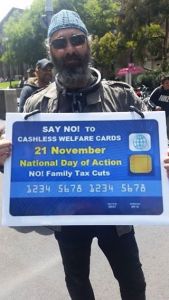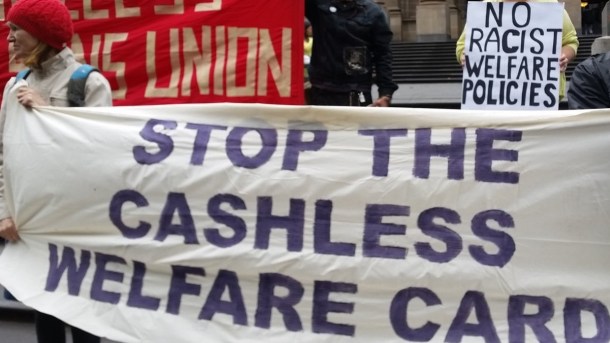“Welfare notes” is an irregular update on unemployment and fight for livable welfare in Australia.
1. Cashless Welfare Card
The federal government has embarked on yet another iteration of income management. The initial income management program was introduced by the Howard government as part of it’s appallingly racist “Norther Territory Intervention”, ostensibly aimed at stopping child abuse. In reality the scheme was an arbitrary array of racist and paternalistic measures that increased indigenous poverty and wrought destruction on indigenous communities.
The new income management trial has been dubbed the “Cashless Welfare Debit Card” and is due to be inflicted on the South Australian community of Ceduna. A twelve month trial of the new welfare card is expected to be expanded in the new year, and will likely affect the Western Australian towns of Kununurra and Halls Creek.
Unlike the Basics Card, which controversially required merchants to sign up to accept the card (basically restricting indigenous people to shopping at major chain outlets), the new “cashless welfare card” is expected to function as a debit card and will presumably be accepted anywhere that has EFTPOS access. According to the DSS website:
The cashless debit card will look and operate like a normal bank card, except it cannot be used to buy alcohol, to gamble or withdraw cash.

Public demonstrations against the Ceduna trial were held in Melbourne, Sydney, Brisbane, Adelaide and Ceduna on 21 Nov. Photo by Kerry Davies.
The kicker is how they intend to achieve this. Detail is thin on the ground, but at community information sessions in Ceduna activists were basically told that the Department of Social Servicess is relying on merchants in the town to discriminate against people utilizing the new welfare card.
The Australian Association of Social Workers utterly eviscerated the plan in a submission to the Senate Community Affairs Committee, here are some highlights:
This Amendment allows for a trial on an aspect of income management that has failed in the past … On the evidence to date, involuntary income management has not been successful in reducing the habitual abuse and associated harm resulting from alcohol, gambling and illegal drugs. …
The technology of the proposed debit card is unproven …
A considerable number of people who do not need income management will be affected by this proposed Amendment … Within the trial sites there will be a large number of welfare recipients who manage their scarce resources well and who do not have a problem with alcohol, illegal drugs or gambling. Their normal patterns of financial management will be disrupted yet they will gain nothing from the trial. The Evaluation New Income Management in the Northern Territory: Final Evaluation Report highlighted a number of such instances. …
This Bill foreshadows a movement toward a more intrusive and disrespectful welfare system that would be rejected by the majority of Australians as paternalistic.
The AASW and others (eg. Eva Cox in this article for the conversation) argue that the government’s Ceduna trial wont even give them the information on income management that they claim to be seeking. The trial wont distinguish between the impact of income management and other new policy changes targeted at Ceduna, a twelve month trial is decidedly short for its stated aims.
I disagree.
The Ceduna trial is not a test of the effectiveness of income management to combat substance misuse. We already know that conditional welfare is disastrous upon the lives of welfare claimants and utterly ineffective in preventing substance misuse.
The cashless welfare card is a trial in politics. It will test whether this level of pervasive control over the lives of welfare claimants can be effectively implemented, it will test the technology, and it will test the politics.
The government has been steadily moving “toward a more intrusive and disrespectful welfare system” for more than a decade. In 2014 significant measures towards a harsher welfare system were rejected by the majority of Australians (although the expanded Work for the Dole program remains). The Ceduna trial is a subtler approach, an experiment upon a largely indigenous community that can be slowly extended and expanded with minimal resistance.
Meanwhile, the failed ‘Basics Card’ continues to operate across the Northern Territory.
2. Work for the Dole evaluation released
According to the ABC:
A study commissioned by the Federal Government has found its work for the dole trial led to just a 2 per cent increase in job placements.
The evaluation was undertaken by the Social Research Centre and probably warrants a longer read by those of us campaigning on the issue of Work for the Dole. The whole thing is online here.
When the government announced the policy I was hopeful that sufficient pressure placed upon potential hosts could prevent the policy’s successful implementation. The evaluation notes:
At up to 15 hours per week per participant, the number of available work experience activities has been sufficient to meet demand – although initially a slow start, once the coordinators and providers were on board with the programme there appeared to be little difficulty in sourcing activities (although there were some exceptions in some of the more regional locations) through host organisations. … However, the suitability of activities has not necessarily aligned with what job seekers are able to do (or want to do).
In some cases, it was reported that activities were created by coordinators (as expected) but then providers were unable to provide suitable job seekers to fill those places because, for example, they had criminal records so could not be placed in that activity, they had transport/access difficulties, or became ineligible for WfD. Some providers and job seekers expressed a concern that too many activities were of the same type (charity shop work and environmental/gardening were cited, for example) that did not always provide sufficient work-like experience or choice.
Work for the Dole participants contacting the Dole Action Group have pointed to the creation of a veritable industry of pseudo-charities that exist solely to churn work for the dole placements.
The best I heard recently was from a person who did a Work for the Dole placement at a charity that (among other things) distributed food parcels on behalf of other charities:
Which is basically they give us food parcels as we have healthcare cards and they are seen to be doing this service.
3. myGov problems
Who needs the Australia Card when we’re all progressively forced into using myGov! From the Sydney Morning Herald:
Mrs Smith, who lives in the Melbourne suburb of Hawthorn East, has been unable to access online services through myGov for three months thanks to an “error” which nobody seems to know how to fix.
Oh fun and games, good thing it’s never happened to anyone else, right?
DHS was unable to comment on whether the problem was widespread. However Centrelink’s Facebook page is littered with daily complaints from customers including images of call wait times on mobile phones of over an hour, and complaints of being locked out of myGov accounts. Fairfax Media has also received correspondence from frustrated users unable to access their myGov accounts on an ongoing basis due to unresolved errors.
4. Centrelink industrial dispute ongoing
The enterprise bargaining agreement (EBA) covering Centrelink staff expired 30 June 2014. When I last posted an update, Centrelink staff had just engaged in a series of short stop-works… There has been little progress since then.
The Canberra Times reports:
The Department of Human Services has cancelled a staff vote on a new enterprise agreement before Christmas.
The Community and Public Sector Union said it was a “tacit acknowledgement” workers were fundamentally opposed to losing rights under the government’s “failed bargaining policy” but Human Services has rejected this assertion as a misrepresentation.
The enterprise agreement ballot of all DHS staff would have closed on December 22 but had now been delayed until February next year, the CPSU said in a statement.
AdvertisementIn September 83 per cent of DHS staff voted ‘no’ to their agreement offers.
As I said back in May, government cut backs and under staffing at Centrelink is making life unbearable for Centrelink workers and welfare claimants alike.
5. Unemployment Rate
ABS Labour force statistics for November report that the seasonally adjusted unemployment rate has fallen by 0.1 percentage points to 5.8%. According to the ABS there are currently 752,300 people unemployed in Australia.
The labour underutilization rate (definition) has also fallen, to 14.3%. Approximately 1,797,600 people are looking for (more) work.
The most recent stats on job vacancies (August 2015) reported approximately 160,200 positions. The next series (November 2015) is not due out until January 2016.
There remain approximately 11.2 people seeking (more) work for every advertised job in Australia.
Bonus!



